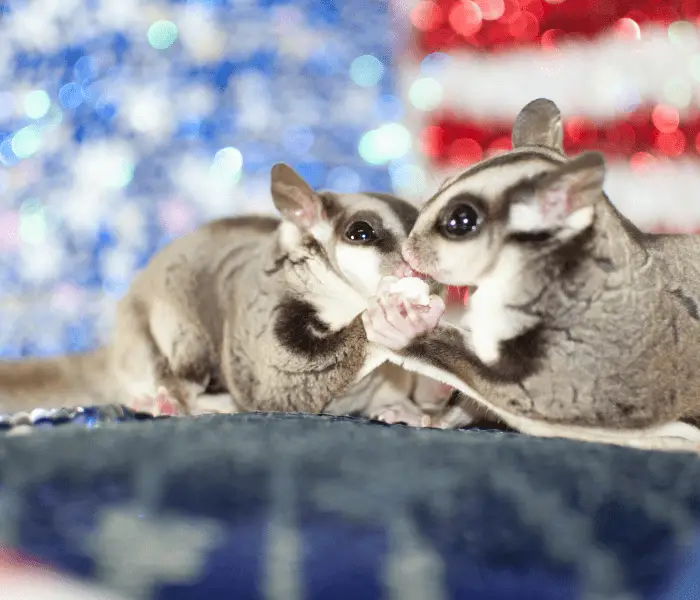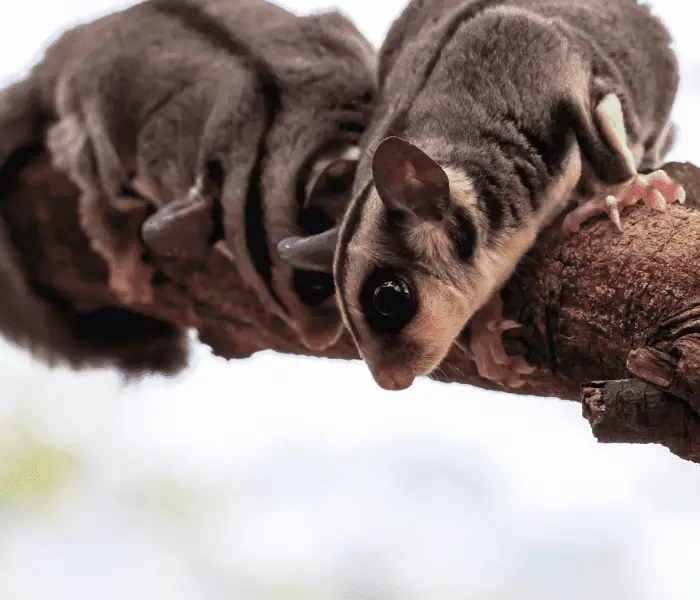This article contains affiliate links, and we may earn a commission at no cost to you if you choose to purchase through these links. I never recommend products that I do not trust or will not advise my veterinary clients and patients to use.
Sugar gliders are small, nocturnal, and very social marsupials that have become popular as exotic pets. They are found naturally in Australia and New Guinea. They are cute, tiny, and unique and thus make for great pets for small families because they are entertaining and affectionate.
Sugar gliders should be kept in groups of two (male and female) or more to meet their social needs. Larger groups of sugar gliders (3 or more) can be kept in a single enclosure, provided that there is adequate space, food, water, and enrichment for all the sugar gliders. If males and females are kept together, it is recommended to neuter the males to prevent unwanted breeding and possible inbreeding.

Normal Sugar Glider Social Structure
Sugar gliders are highly social animals and form strong and cohesive groups called colonies. Colonies usually comprised up to twelve adult individuals with one to three males. They live together in trees and are socially dependent on one another, syncing their sleep and wake patterns.
The social structure is hierarchical – formed by both males and females; however, there is usually only one dominant male that bears the responsibility of patrolling the territory and scent-marking the territory. The dominant male is usually more aggressive in order to protect his colony and their resources.
Sugar gliders maintain their social structures by scent-marking. They mark members of their colonies, their mates, and themselves. They can quickly tell non-members from resident colony members by their scent.
Can I keep One Sugar Glider On Its Own?
It is not advised to keep a sugar glider on its own as they are highly reliant on social interaction and engagement to thrive in their environment. Although gliders can form strong bonds with humans, they need to be with their own kind. Gliders can become depressed if kept on their own for a long time.
Sugar gliders are nocturnal, meaning they are more active during the night and sleep during the day. On the other hand, humans are diurnal. We are active during the day – going to work or school and sleeping at night. This is a valid reason to have more than one sugar glider, so they may keep each other company while we are asleep.
If you would like to read more on the topic of how to tell whether your sugar glider is happy and how to calm a stressed sugar glider, have a look at articles linked on each topic.

Under What Circumstances Should You Keep Single A Sugar Glider By Itself?
Although sugar gliders are social animals and should be kept in their social structures, there are some cases where it is necessary to keep a sugar glider on its own.
1. Quarantine
Upon acquiring a new sugar glider, it is recommended for the new glider to be housed separated for at least three weeks to ensure that the animal is healthy before introducing it to the new colony.
2. Sick Or Injured Sugar Gliders
Sick and injured animals should be removed from the colony to avoid the spread of disease to the other members and to protect the injured animal from further injury or for rehabilitation. Seek veterinary advice immediately to ensure the well-being of the individual animal and the colony.
3. Bullied Sugar Gliders
A bullied or rejected glider should be removed and housed separately. The process of reintroduction (discussed below) can be started again.
If you want to learn more about aggression and cannibalism in sugar gliders, look at this article.
How To Add A New Sugar Glider To The Colony: 4 Steps
Sugar gliders form tight-knit, territorial social structures and thus can be aggressive towards unfamiliar sugar gliders, often resulting in severe injury or death of new sugar gliders. Therefore, introducing a new glider to your existing colony should be executed carefully using the steps below.
Sugar gliders use scents to recognize each other. The smell is used to introduce new sugar gliders to a resident colony by mingling the scent of the new member with that of the colony.
1. Quarantine
New sugar gliders must be quarantined for three weeks beforehand to make sure they are healthy before being integrated into the colony.
2. Swop Hammocks
Every evening, the nesting pouches or hammocks of the colony members need to be moved to the enclosure of the new glider and replaced with clean pouches.
After the quarantine period for the new sugar glider is over, you may place some of the new sugar glider’s used hammocks in the cage with your existing colony to introduce the scent of the new glider.
3. Place The New Sugar Glider In A Separate Enclosure Next To The Existing Colony’s Enclosure
Once the quarantine period is over, and the new glider is healthy, the enclosure may be moved beside the enclosure of the colony for approximately ten days.
4. Introduce the New Sugar Glider To The Existing Colony’s Enclosure
After about ten days, the new glider can be introduced to the colony during the day while they are asleep.
What Must I Do If The Introduction Steps Fail?
In the case that there is severe aggression between the existing colonies and the new sugar glider, the new sugar glider should be removed, and the process needs to be repeated from step two onwards.
You may repeat steps two to four up to three times. If the introduction process is still unsuccessful, rehoming of the new sugar glider should be considered to avoid aggression between sugar gliders and to prevent the new sugar glider from being kept on its own for too long.
Things To Consider Before Getting A New Sugar Glider
Sugar gliders can live up to ten years in captivity and therefore require long-term commitment. Sugar gliders may be small in size, but they are a big responsibility.
Important questions to ask before getting a new sugar glider:
- Are you committed enough to keep your sugar glider for the entirety of its lifespan? (11- 15 years)
- Do you have a larger enough space for your sugar glider’s enclosure, along with all the toys and accessories required?
- Do you have a veterinarian close by with expertise in sugar gliders or other marsupials?
- Does your lifestyle allow you to provide adequate time and care for your sugar glider? I.e., will you be able to interact with your sugar glider(s) in early mornings or late evenings when they are awake?
- Do you have the finances to provide for more than one sugar glider so they are never alone?
1. Housing Considerations For Sugar Gliders
- The enclosure or cage should be large. A minimum of 6 x 6 x 6 ft (2 x 2 x 2 m) is recommended. The enclosures should favor height over floor space. This Critter Nation Deluxe Cage is a good example. Some of the levels may be removed to create more vertical jumping space.
- The cage wires should be horizontal to facilitate climbing, and the gap between wires should be no larger than half an inch.
- Provide lots of toys, ladders, ropes, and branches for climbing and swinging to mimic the natural environment of trees. A climbing toy such as this climbing vine or these climbing ropes is a great way to create a fun and stimulating environment for your sugar gliders.
- Provide a nest box, pouch, or bag.
- Line cages with newspaper or wood shavings – just ensure these substrates will not be toxic if accidentally ingested.
- Replace the cage floor covering and clean the cage with non-toxic soap and water at least once a week.
- The cage should be protected from direct sunlight and drafts – maintain a temperature of 75-80 degrees Fahrenheit (24-27°C). For more information on how to keep sugar gliders warm in winter, have a look at this article.
- The latch to the cage should be secure to avoid accidental opening.
- The enclosure should not be accessible to other pets, such as cats and dogs, to avoid injury that might be perceived as predators by the sugar gliders.
2. Temperament and behavior
- Allow your sugar glider to bond with you through frequent interaction, and allow your sugar glider to ride in your pocket for a nap during the day (keep all doors and windows closed while doing this to avoid accidental escaping).
- Although they aren’t aggressive, they will bite if scared or threatened. Always be cautious and gentle when handling your sugar glider.
3. Diet
- Sugar gliders are omnivorous; their natural diet consists of tree sap, nectar, and small insects.
- There are various homemade diet formulations, such as the Bourbon’s Modified Leadbeater (BML) diet, which provides a healthy and balanced substitute for the natural diet.
- Always ensure that there is fresh, cool water in the enclosure and that the water is changed at least twice a day.
For more information on sugar glider diet and supplementation and obesity in sugar gliders, please click on the respective links to read more on the topic.
Remember to always do your research on a reputable sugar glider breeder who can provide the
paperwork on the origin of the animal, medical status, and advice on how to care for the animal.
Resources
- Banks, R., 2013. Exotic small mammal care and husbandry. Hoboken: John Wiley, pp.81 – 92. https://onlinelibrary.wiley.com/doi/book/10.1002/9781119265405
- Booth, R., 2003. Sugar gliders. Seminars in Avian and Exotic Pet Medicine
- Dierenfeld, E., 2009. Feeding Behavior and Nutrition of the Sugar Glider (Petaurus breviceps). Veterinary Clinics of North America: Exotic Animal Practice, 12(2), pp.209-215.
- Meredith, A. and Redrobe, S., 2002. BSAVA manual of exotic pets. 4th ed. Quedgeley: British Small Animal Veterinary Association, pp. 102 – 106 25. https://www.researchgate.net/publication/240493099_The_BSAVA_Manual_of_Exotic_Pets_4th_edn
- Scheun Juan, Geiser Fritz, Ganswindt Andre, Nowack Julia (2019) Non-invasive evaluation of stress hormone responses in a captive population of sugar gliders (Petaurus breviceps). Australian Mammalogy 42, 176-184. https://doi.org/10.1071/AM18044
- Schuppli, C. A., Fraser, D., & Bacon, H. J. (2014). Welfare of non-traditional pets. Rev Sci Tech, 33(1), 221-231 https://www.wellbeingintlstudiesrepository.org/wileapet/2/
- Tynes, V., n.d. Behavior of Exotic Pets. Wiley-Blackwell, pp.181-189.
